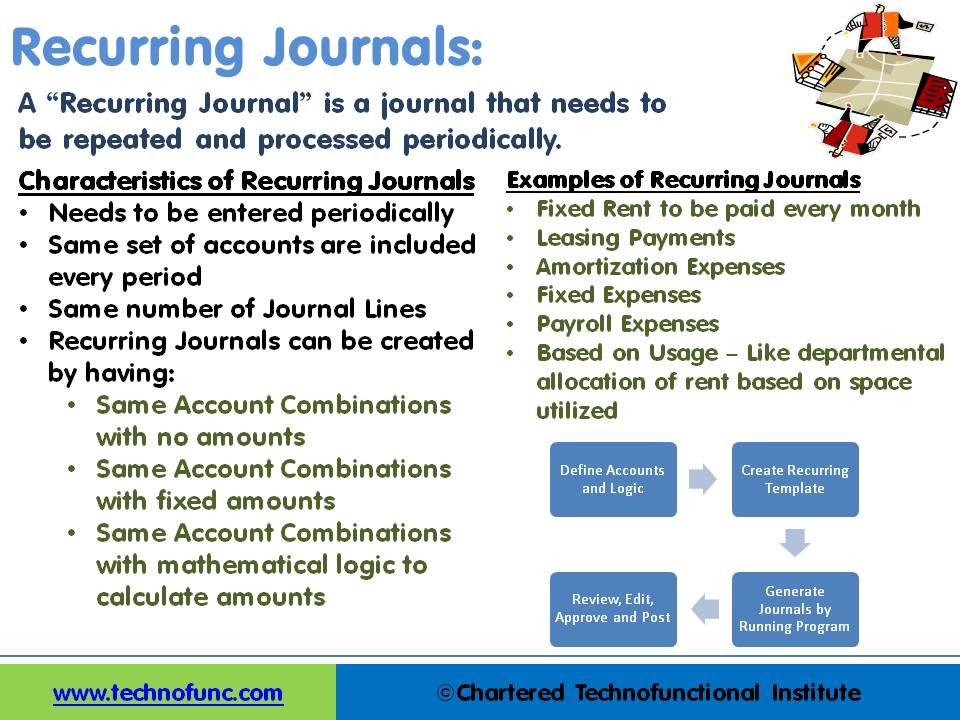- Home
- Business Processes
- Industry Knowledge
- Aerospace Industry
- Automotive Industry
- Banking Domain
- BFSI Industry
- Consumer/ FMCG Industry
- Chemicals Industry
- Engineering & Construction
- Energy Industry
- Education Domain
- Finance Domain
- Hospitality Domain
- Healthcare Industry
- Insurance Domain
- Retail Industry
- Travel and Tourism Domain
- Telecom Industry
- Leadership Skills
- eLearning
- Home
- Functional
- General Ledger (Record to Report)
- GL - Recurring Journal Entries
GL - Recurring Journal Entries
A “Recurring Journal” is a journal that needs to be repeated and processed periodically. Recurring Entries are business transactions that are repeated regularly, such as fixed rent or insurance to be paid every month. Learn the various methods that can be used to generate recurring journals. See some examples and explore the generic process to create recurring journals in any automated system.
What is a Recurring Journal?
A “Recurring Journal” is a journal that needs to be repeated and processed periodically. Recurring Entries are business transactions that are repeated regularly, such as fixed rent or insurance to be paid every month. Each accounting period the journal should have the same accounts but the amounts could be different. A recurring journal entry enables you to automate similar or repeating entries. For users who need to post certain transactions frequently with few or no changes, it is an advantage to use recurring journals.
Recurring entries allow for common repeatable transactions to be saved in a template and created in multiple accounting periods upon request, making it unnecessary to retype the entire transaction thereby improving productivity. The Auto-generation of recurring accounting entries minimizes the occurrence of errors and omissions. Systems allow the generation of recurring entries at weekly, monthly, or any other frequency.
Characteristics of Recurring Journals:
-
Needs to be entered periodically
-
The same set of accounts are included every period
-
The same number of Journal Lines
-
Logic exists to define the line selection criteria
-
Simplifies the process of recording repetitive journal entries
-
Creates same journal entries with varying or same amounts in different accounting periods
Methods to Create Recurring Journals:
1. Same Account Combinations with no amounts:
This is useful when the same accounts need to be used every period however the amounts get changed every time. In this scenario, the template is defined with no amounts, and amounts are entered manually every accounting period for which the entry needs to be generated.
2. Same Account Combinations with fixed amounts:
This is useful when both accounts and amounts can be pre-determined. A good example of this scenario is fixed rent payable each month on a specific date. In this case, the template is defined with actual amounts, and journals are created and posted for relevant accounting periods.
3. Same Account Combinations with mathematical logic to calculate amounts:
This is useful when accounts can be pre-determined and amounts will be based on some logic or pre-defined formula. A good example of this scenario could be defining salesmen accounts as the pre-determined accounts. The commission is to be paid to these salesmen as a fixed percentage of sales made by each salesman during the month and sales for each salesman are recorded in separate accounts. A recurring journal can be defined that can look for the balance in respective sales accounts at the end of the period and automatically calculate the commission and create the required accounting entry for commission payable.

Examples of Recurring Journals:
This method works best for repeatable transactions. For example annual expenses that can be charged through twelve equal monthly entries such as, rent or insurance expense allocation or annual lease rentals. Each month 1/12th of the total annual expense can be debited and credited to the appropriate accounts and appear as the current month’s actual transaction. Users can benefit by creating a recurring entry for some of the business scenarios listed below:
- Fixed Rent to be paid every month
- Fixed Insurance to be paid every month
- Leasing Payments
- Amortization Expenses
- Fixed Expenses
- Payroll Expenses
- Based on Usage – Like departmental allocation of rent based on space utilized
- Depreciation
- Allocations
Generic Process to Create Recurring Journals:
Users need to define recurring journal formulas for transactions that they want to repeat every accounting period, such as accruals, depreciation charges, and allocations. The formulas can be simple or complex but need to have some logic of ascertaining the amounts for each of the accounts that need to be repeated. Each formula can use fixed amounts and/or account balances and period-to-date or year-to-date balances from the current period, prior period, or same period last year. Given below is a generic process flow to define recurring journals:
- Define Accounts, Amounts or Formula or Logic
- Create Recurring Template
- Define the accounting periods for which the recurring journals need to be created
- Generate Journals by Running automated recurring journals creation program
- Enter missing data in case of Skelton journals – missing amounts
- Review, Edit, Approve and Post recurring journals
Allocations V/s Recurring Journals:
Recurring Journals are for transactions that repeat every accounting period as explained above and allocation Journals are for single journal entry using an accounting or mathematical formula to allocate revenues and expenses across a group of accounting dimensions like cost centers, departments, divisions, locations, or product lines depending upon usage factors.
Related Links
You May Also Like
-
A joint venture (JV) is a business agreement in which the parties agree to develop, for a finite time, a new entity and new assets by contributing equity. They exercise control over the enterprise and consequently share revenues, expenses and assets. A joint venture takes place when two or more parties come together to take on one project.
-
GL - Different Type of Journals
Two basic types of journals exist: general and special. In this article, the learner will understand the meaning of journalizing and the steps required to create a journal entry. This article will also discuss the types of journals and will help you understand general journals & special journals. In the end, we will explain the impact of automated ERPs on the Journalizing Process.
-
As the business grows, the company may want to transition to a branch structure as branches are allowed to conduct a much broader range of activity than representative offices. Branches can buy and sell goods, sign contracts, build things, render services, and generally everything that a regular business can do. A company expands its business by opening up its branch offices in various parts of the country as well as in other countries.
-
General Ledger - Advanced Features
Modern automated general ledger systems provide detailed and powerful support for financial reporting and budgeting and can report against multiple legal entities from the single system. These systems offer many advanced functionalities right from journal capture to advanced reporting. This article will provide an overview of some advanced features available in today's General Ledgers.
-
In this article we will discuss various types of "Management Entities". Various types of operational units, are created by management, to effectively run, manage and control their business. Different types of functional units, and divisional units, are widely used across industry.
-
Network Organizational Structures
The newest, and most divergent, team structure is commonly known as a Network Structure (also called "lean" structure) has central, core functions that operate the strategic business. It outsources or subcontracts non-core functions. When an organization needs to control other organizations or agencies whose participation is essential to the success, a network structure is organized.
-
Accrued expenses, sometimes referred to as accrued liabilities, are expenses that have been incurred but have not been recorded in the accounts. Discuss the need to record accrued liabilities and why they require an adjustment entry. Understand the treatment for these entries once the accounting period is closed and learn to differentiate when the commitments become liabilities.
-
Functional Organizational Structures
A functional organizational structure is a structure that consists of activities such as coordination, supervision and task allocation. The organizational structure determines how the organization performs or operates. The term organizational structure refers to how the people in an organization are grouped and to whom they report.
-
Operational Structures in Business
Large organizations grow through subsidiaries, joint ventures, multiple divisions and departments along with mergers and acquisitions. Leaders of these organizations typically want to analyze the business based on operational structures such as industries, functions, consumers, or product lines.
-
Multitude of these legal and operational structures clubbed with accounting and reporting needs give rise to many reporting dimensions at which the organization may want to track or report its operational metrics and financial results. This is where business dimensions play a vital role.
Explore Our Free Training Articles or
Sign Up to Start With Our eLearning Courses

About Us
Learning
© 2023 TechnoFunc, All Rights Reserved










